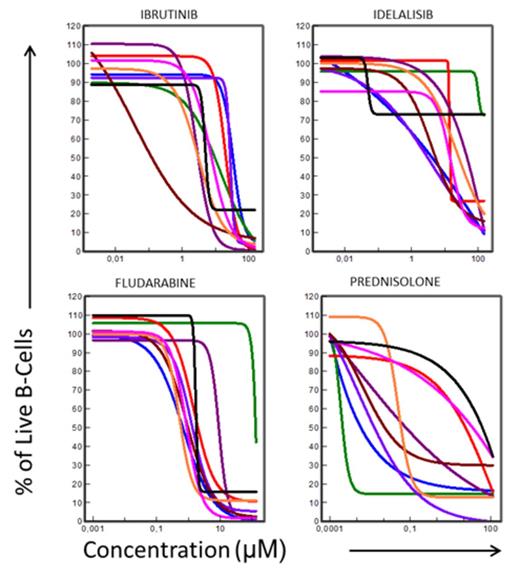Abstract
Background and Objectives: B-cell chronic lymphoid leukemia (CLL) is a lymphoproliferative disorder where specific microenvironment between B-cells and nurse-like Cells (NLC) seem to be involved in disease progression providing cell survival, proliferation and drug resistance. Consequently, functional screening platforms that can assess drug candidates within this microenvironment are needed. Our aim is to show the ability of the Exvitech® automated flow cytometry platform to screen agents that interfere with the microenvironmentxs protective scenario such as ibrutinib or idelalisib or standard CLL drugs such as fludarabine or prednisolone. This approach will allow us to select candidates in an in vitro assay and could personalize the treatment according the response to the drugs.
Patients and methods: We have adapted Jan Burger's published assay1. Peripheral blood mononuclear cells (PBMCs) from not previously treated CLL patients were isolated by density gradient centrifugation over Ficoll-Pacque and were used fresh (N=14) or cryopreserved (N=6). B-cells were assessed to be >90% viable by flow cytometry. NLC co-cultures were stablished by suspending PBMCs from CLL patients in complete RPMI medium with 10% FBS to a concentration of 2x107/ml. Cells were incubated for 14 days in 96-well plates and presence of NLC was confirmed by microscopy. After that, viability was investigated in B-cells treated with 8 concentrations of ibrutinib, idelalisib, fludarabine and prednisolone after 72h of incubation with annexin-V and the appropriate CLL flow cytometry markers. Drug response was evaluated as a depletion survival index of the B-cell population relative to the average of the control wells with NLC but without drug.
Results: As expected, depletion of B-cells cultured without NLCs were significant greater than with NLC after the 72h incubation supporting the assay where NLCs protect B-CLL cells from in vitro spontaneous apoptosis. In a similar way, viability of fresh samples with NLC was higher than the corresponding frozen samples (84% vs 25%), though both could be used. Our results show a lower pharmacological median potency, measured as a higher EC50, when we work with NLC versus without NLC for ibrutinib (10µM vs 4µM), idelalisib (17µM vs 0.4µM) and prednisolone (3.5µM vs 1.5µM). However, the effect of fludarabine seems to be independent of the presence of the NLC in the cell culture (7µM vs 6µM). This is consistent with the protective role of microenvironment; more pronounced for ibrutinib and idelalisib. Interestingly with NLC, for each drug there is a significant interpatient variability (Figure 1); each line correspond to a different patient, reflecting the possibility that patients might be more sensitive or resistant to a certain drug in this particular scenario. There is a higher degree of patient sample stratification for idelalisib, fludarabine or prednisolone, where there are still an important % of B-cells alive for some patients after drug exposure at high concentration, supporting the notion of drug resistance. Synergism between some of these drugs was evaluated in 3 samples, with some samples being more synergistic than other, requiring a larger number of samples.
Conclusions: Cellular and molecular interactions between B-cells and the microenvironment represented here with the NLC, have become an attractive target for CLL therapy. Because novel drugs such as ibrutinib or idelalisib are transforming CLL therapy targeting the microenvironment, novel technologies that could predict its effect are necessary. Here we have adapted a Nurse-Like Cell assay mimicking the microenvironment published by Burger1 to our ExviTech platform. The automated platform enables scaling of the data points acquired with this assay supporting characterization of drug activity by pharmacological dose response curves, as well as exploring synergistic interactions. As showed in the results and illustrated in Figure 1, there is a interpatient variability of the pharmacological profile for the studied drugs, if clinically validated, could help guiding a personalized treatment selection; measuring the drug activity inside this particular microenvironment responsible of drug resistance.
1.- Burger JA et al. Blood. 2000 Oct 15;96(8):2655-63.
Primo:Vivia Biotech: Employment. Martinez:Vivia Biotech: Membership on an entity's Board of Directors or advisory committees. Gorrochategui:Vivia Biotech: Employment. Espinosa:Vivia Biotech: Employment. Arroyo:Vivia Biotech: Employment. Ballesteros:Vivia Biotech: Employment. Hernandez:Vivia Biotech: Employment.
Author notes
Asterisk with author names denotes non-ASH members.


This feature is available to Subscribers Only
Sign In or Create an Account Close Modal